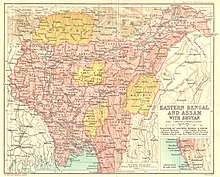Partition of Bengal in 1905
The division of Bengal in 1905 was carried out by the British ostensibly for administrative reasons, but was reversed in 1912 after several violent unrest.
history
The Bengal Presidency was established as an administrative unit of the British East India Company in 1684. Initially, the area comprised only small territories on the coast of Bengal. With the increasing expansion of British rule, the area of the presidency grew and for a time included not only today's Bengal, but large parts of eastern and northern India. In 1858 the East India Company's possessions were taken over by the British Crown. The administrative seat was in the Fort William fortress in Calcutta . In 1877 Queen Victoria assumed the title of Empress of India and the British declared Calcutta the capital of the "Crown Colony of India".
On October 16, 1905, Viceroy Lord Curzon announced the administrative division of the province of Bengal. The provinces thus newly formed were Bengal (the western part, which roughly included the area of the present-day Indian states of West Bengal , Odisha , Bihar and Jharkhand ) and East Bengal and Assam , which roughly included present-day Bangladesh and the present-day Indian state of Assam with neighboring states. The main argument for the administrative division was the sheer size of the previous presidency, which covered about the area of France, but with about 80 million inhabitants at the time, had about twice as many inhabitants as this. Calcutta remained the capital of western Bengal and Dakka became the capital of the eastern province . While the old Bengal presidency had a Hindu majority, the newly formed province of East Bengal and Assam had a Muslim majority.
Indian nationalists saw this division as a means for the British colonial rulers to sow discord among the Bengali people, who had always formed a unity in language and history, and to pit Hindus and Muslims against each other. After several violent riots, the British revised the partition of Bengal in 1912. Bengal was reunited, but the new provinces of Assam and Bihar and Orissa were separated from it. This time this division essentially followed the borders of the language areas. The Bengal presidency found its formal end with the Montague-Chelmsford reforms from 1919 to 1921. When in 1947 the former British colony of India was divided into a Hindu part and a Muslim part according to the Mountbatten Plan , the second division of Bengal took place again along almost the same line same border lines as 1905.
Individual evidence
- ↑ N. Jayapalan: History Of India (from National Movement To Present Day) . tape 4 . Atlantic Publishers & Dist, New Delhi 2001, ISBN 81-7156-917-X , pp. 15 (English, limited preview in Google Book Search).
